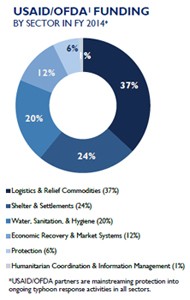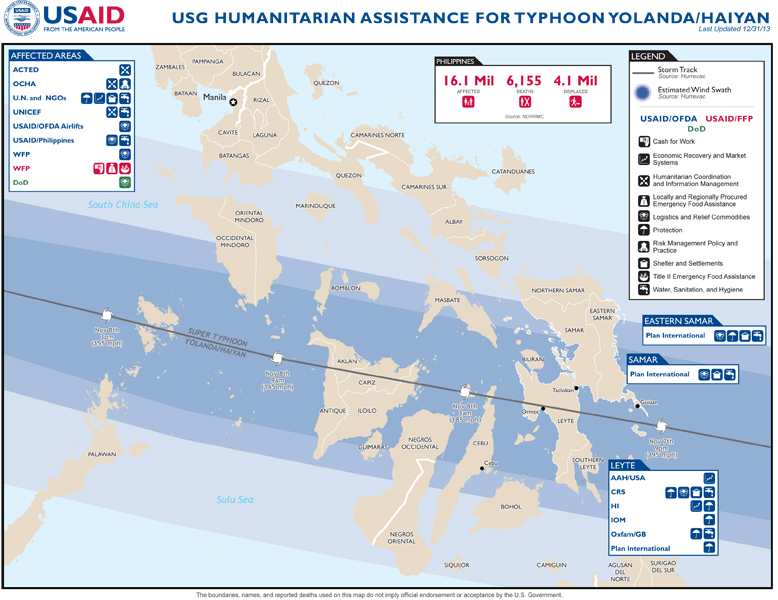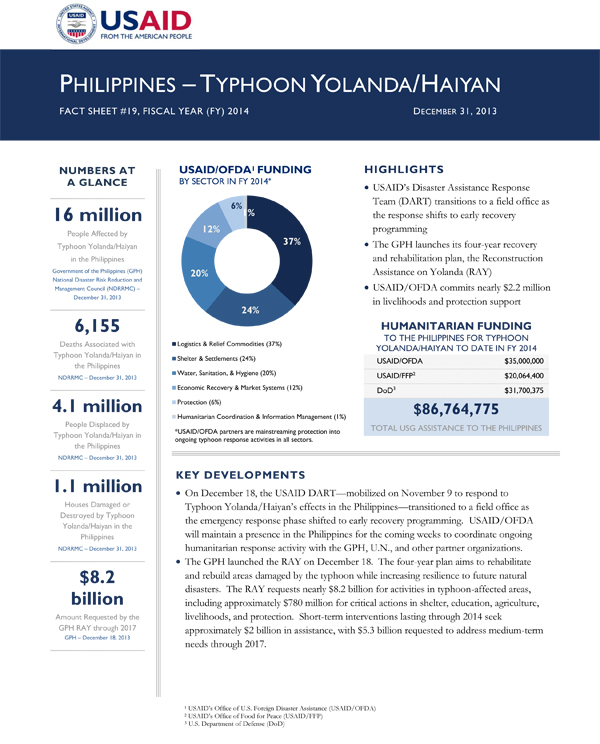- What We Do
- Agriculture and Food Security
- Democracy, Human Rights and Governance
- Economic Growth and Trade
- Education
- Ending Extreme Poverty
- Environment and Global Climate Change
- Gender Equality and Women's Empowerment
- Global Health
- Water and Sanitation
- Working in Crises and Conflict
- Disaster Assistance
- Political Transition Initiatives
- Conflict Mitigation and Prevention
- Countering Violent Extremism
- Disaster Risk Reduction
- Peacebuilding and Reconciliation
- Providing Safe & Secure Environments for Development
- Recovering From Crisis
- Resilience
- Tech Challenge for Atrocity Prevention
- World Humanitarian Day
- U.S. Global Development Lab
December 31, 2013
Numbers At A Glance
16 million
6,155
4.1 million
1.1 million
$8.2 billion
Humanitarian Funding:
To The Philippines For Typhoon Haiyan/Yolanda To Date In FY2014:

| USAID/OFDA | $35,000,000 |
| USAID/FFP | $20,064,400 |
| DoD | $31,700,375 |
| TOTAL | $86,764,775 |
Typhoon Haiyan / Yolanda Fact Sheet #19 - 12/31/2013 ![]() (pdf - 219k)
(pdf - 219k)
Highlights
USAID’s Disaster Assistance Response Team (DART) transitions to a field office as the response shifts to early recovery programming.
The GPH launches its four-year recovery and rehabilitation plan, the Reconstruction Assistance on Yolanda (RAY).
USAID/OFDA commits nearly $2.2 million in livelihoods and protection support
Key Developments
On December 18, the USAID Disaster Assistance Response Team (DART)—mobilized on November 9 to respond to Typhoon Yolanda/Haiyan’s effects in the Philippines—transitioned to a field office as the emergency response phase shifted to early recovery programming. USAID’s Office of U.S. Foreign Disaster Assistance will maintain a presence in the Philippines for the coming weeks to coordinate ongoing humanitarian response activity with the Government of the Philippines (GPH), the U.N., and other partner organizations.
The GPH launched its Reconstruction Assistance on Yolanda (RAY) plan on December 18. The four-year plan aims to rehabilitate and rebuild areas damaged by the typhoon while increasing resilience to future natural disasters. The RAY requests nearly $8.2 billion for activities in typhoon-affected areas, including approximately $780 million for critical actions in shelter, education, agriculture, livelihoods, and protection. Short-term interventions lasting through 2014 seek approximately $2 billion in assistance, with $5.3 billion requested to address medium-term needs through 2017.
AGRICULTURE AND FOOD SECURITY
The U.N. reports that nearly 5.6 million people require food assistance and support to prevent food insecurity and restore agricultural and fishing livelihoods.
As of December 29, the U.N. World Food Program (WFP) had dispatched nearly 12,800 metric tons (MT) of food, including approximately 12,500 MT of rice, 268 MT of high-energy biscuits (HEBs), and 22 MT of specialized nutrition products.
More than 22,400 farmers have received 40 kilograms of rice seed each to date, representing approximately 51 percent of the targeted population of 44,000 beneficiaries.
Earlier this month, USAID/FFP contributed an additional $10 million in assistance to WFP in the Philippines. This assistance will be implemented using a variety of food assistance modalities, including the purchase of 5,000 MT of rice, sufficient to help feed 500,000 people for one month; funding for the regional procurement of additional food aid; and support for cash-for-work activities designed to promote early recovery and the rebuilding of livelihoods. To date, USAID/FFP has provided more than $20 million to WFP in the Philippines for the provision of food assistance, including contributions of in-kind food and regionally purchased rice.
NUTRITION
Humanitarian partners have screened more than 49,000 children under five years of age for malnutrition, with 1,490 children identified as suffering from acute malnutrition, including 161 cases of severe acute malnutrition and approximately 1,330 cases of moderate acute malnutrition, to date.
Blanket supplemental feeding programs have reached nearly 27,000 children between six months and five years of age with 50 MT of HEBs and ready-to-use supplementary foods in Capiz, Eastern Samar, Iloilo, and Leyte provinces to prevent new cases of acute malnutrition, according to WFP and the Nutrition Cluster—the coordinating body for humanitarian nutrition activities, comprising U.N. agencies, non-governmental organizations (NGOs), and other stakeholders. In addition, humanitarian partners have reached more than 5,000 pregnant and lactating women with infant and young child feeding services at 21 baby-friendly spaces.
LIVELIHOODS
Humanitarian organizations reported on December 27 that the typhoon affected approximately 5.9 million workers, of whom 2.6 million have been identified as the most vulnerable. The Early Recovery and Livelihoods Cluster is targeting assistance to 400,000 of the most vulnerable persons.
The U.N. reported that as of December 20, humanitarian organizations had engaged more than 14,000 typhoon-affected individuals in emergency employment programs over the past month.
As of December 26, more than 18,100 beneficiaries had received cash transfers through NGO and GPH Department of Social Welfare and Development partnerships. The GPH’s conditional cash transfer program began on December 20, with more than 1,700 households in two typhoon-affected municipalities in Leyte Province each receiving approximately $30 and rice provisions.
USAID/OFDA recently committed nearly $2.2 million to support livelihoods opportunities and provide protection assistance for the most vulnerable typhoon-affected populations through partner Handicap International (HI). HI is working in Leyte to identify vulnerable populations and restore their livelihoods through cash transfers, the provision of livelihoods assets, and relevant training.
SHELTER AND SETTLEMENTS
On December 26, the Shelter Cluster published final results from a joint shelter–water, sanitation, and hygiene (WASH) assessment conducted between November 28 and December 12. The assessment found high levels of structural damage across typhoon-affected areas, with only 22 percent of households in those areas reporting no damage. Of affected households, 48 percent stated that they needed support to complete reconstruction or repairs.
To date, Shelter Cluster partners have provided basic emergency shelter materials, such as plastic sheeting, tents, tools, and rope, to approximately 238,000 households across affected areas. In addition, nearly 24,000 households have received support for self-recovery efforts through shelter repair kits, cash transfers, and construction materials.
USAID/OFDA has provided nearly $6.8 million to support the shelter needs of typhoon-affected populations.
INTERNATIONAL ASSISTANCE
The Republic of Korea (RoK) deployed a military contingent to the Philippines on December 28 to provide logistical and engineering assistance to ongoing humanitarian operations. The RoK forces—accompanied by heavy engineering equipment—plan to remain in Leyte and Samar provinces for one year, according to the U.N.
As of December 31, international donors had pledged approximately $583 million to address the needs of populations affected by Typhoon Yolanda/Haiyan. The total amount pledged represents nearly 74 percent of the $791 million requested by the U.N.’s Typhoon Haiyan Strategic Response Plan for the Philippines.









Comment
Make a general inquiry or suggest an improvement.